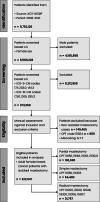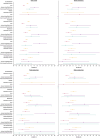Racial disparities in surgical outcomes after mastectomy in 223 000 female breast cancer patients: a retrospective cohort study
- PMID: 38052017
- PMCID: PMC10871660
- DOI: 10.1097/JS9.0000000000000909
Racial disparities in surgical outcomes after mastectomy in 223 000 female breast cancer patients: a retrospective cohort study
Abstract
Background: Breast cancer mortality and treatment differ across racial groups. It remains unclear whether such disparities are also reflected in perioperative outcomes of breast cancer patients undergoing mastectomy.
Study design: The authors reviewed the American College of Surgeons National Surgical Quality Improvement Program (ACS-NSQIP) database (2008-2021) to identify female patients who underwent mastectomy for oncological purposes. The outcomes were stratified by five racial groups (white, Black/African American, Asian, American Indian/Alaska Native, and Native Hawaiian/Pacific Islander) and included 30-day mortality, reoperation, readmission, surgical and medical complications, and non-home discharge.
Results: The study population included 222 947 patients, 68% ( n =151 522) of whom were white, 11% ( n =23 987) Black/African American, 5% ( n =11 217) Asian, 0.5% ( n =1198) American Indian/Alaska Native, and 0.5% ( n =1018) Native Hawaiian/Pacific Islander. While 136 690 (61%) patients underwent partial mastectomy, 54 490 (24%) and 31 767 (14%) women received simple and radical mastectomy, respectively. Overall, adverse events occurred in 17 222 (7.7%) patients, the largest portion of which were surgical complications ( n =7246; 3.3%). Multivariable analysis revealed that being of Asian race was protective against perioperative complications [odds ratio (OR)=0.71; P <0.001], whereas American Indian/Alaska Native women were most vulnerable to the complication occurrence (OR=1.41; P <0.001). Black/African American patients had a significantly lower risk of medical (OR=0.59; P <0.001) and surgical complications (OR=0.60; P <0.001) after partial and radical mastectomy, respectively, their likelihood of readmission (OR=1.14; P =0.045) following partial mastectomy was significantly increased.
Conclusion: The authors identified American Indian/Alaska Native women as particularly vulnerable to complications following mastectomy. Asian patients experienced the lowest rate of complications in the perioperative period. The authors' analyses revealed comparable confounder-adjusted outcomes following partial and complete mastectomy between Black and white races. Their findings call for care equalization in the field of breast cancer surgery.
Copyright © 2023 The Author(s). Published by Wolters Kluwer Health, Inc.
Conflict of interest statement
The authors declare that the research was conducted in the absence of any commercial or financial relationships that could be construed as a potential conflict of interest.
Sponsorships or competing interests that may be relevant to content are disclosed at the end of this article.
Figures





Similar articles
-
Disparities in Breast Cancer Treatment and Reconstruction Among Native Hawaiian and Pacific Islander Women: Systematic Review and Meta-Analysis.J Surg Oncol. 2025 May;131(6):1002-1012. doi: 10.1002/jso.27994. Epub 2024 Nov 25. J Surg Oncol. 2025. PMID: 39584424 Free PMC article.
-
Associations between race and ethnicity and perioperative outcomes among women undergoing hysterectomy for adenomyosis.Fertil Steril. 2024 Jun;121(6):1053-1062. doi: 10.1016/j.fertnstert.2024.02.003. Epub 2024 Feb 10. Fertil Steril. 2024. PMID: 38342374
-
Racial and ethnic disparities in surgical care for endometriosis across the United States.Am J Obstet Gynecol. 2022 Jun;226(6):824.e1-824.e11. doi: 10.1016/j.ajog.2022.01.021. Epub 2022 Jan 31. Am J Obstet Gynecol. 2022. PMID: 35101410
-
Racial and ethnic differences in reconstructive surgery for apical vaginal prolapse.Am J Obstet Gynecol. 2021 Oct;225(4):405.e1-405.e7. doi: 10.1016/j.ajog.2021.05.002. Epub 2021 May 10. Am J Obstet Gynecol. 2021. PMID: 33984303
-
A comparative analysis of males and females with breast cancer undergoing mastectomy using the American College of Surgeon's National Surgical Quality Improvement Project (NSQIP).Breast Cancer Res Treat. 2022 Jul;194(2):201-206. doi: 10.1007/s10549-022-06628-x. Epub 2022 May 27. Breast Cancer Res Treat. 2022. PMID: 35622242 Review.
Cited by
-
Perioperative safety of risk-reducing mastectomy.Br J Cancer. 2024 Dec;131(11):1721-1723. doi: 10.1038/s41416-024-02897-z. Epub 2024 Nov 5. Br J Cancer. 2024. PMID: 39501091 No abstract available.
-
Breast Implant Removal Surgery: A Data-driven Look at Growing Trends.Plast Reconstr Surg Glob Open. 2024 Dec 20;12(12):e6402. doi: 10.1097/GOX.0000000000006402. eCollection 2024 Dec. Plast Reconstr Surg Glob Open. 2024. PMID: 39712382 Free PMC article. No abstract available.
-
Short-Term Outcomes of Breast Cancer Surgery by Race-Ethnicity in the Military Health System.Ann Surg Oncol. 2025 May 21. doi: 10.1245/s10434-025-17449-9. Online ahead of print. Ann Surg Oncol. 2025. PMID: 40399598
-
Safety of Combined Versus Isolated Cosmetic Breast Surgery and Abdominoplasty: Insights from a Multi-institutional Database.Aesthetic Plast Surg. 2025 Apr 10. doi: 10.1007/s00266-025-04800-4. Online ahead of print. Aesthetic Plast Surg. 2025. PMID: 40208323
-
Disparities in Breast Cancer Treatment and Reconstruction Among Native Hawaiian and Pacific Islander Women: Systematic Review and Meta-Analysis.J Surg Oncol. 2025 May;131(6):1002-1012. doi: 10.1002/jso.27994. Epub 2024 Nov 25. J Surg Oncol. 2025. PMID: 39584424 Free PMC article.
References
-
- National Cancer Institute. Surveillance Epidemiology, and End Results (SEER) Program. Cancer Stat Facts: female Breast Cancer. 2023 Accessed September 1, 2023. https://seercancergov/statfacts/html/breast.html
-
- Jatoi I, Sung H, Jemal A. The Emergence of the Racial Disparity in U.S. Breast-Cancer Mortality. N Engl J Med 2022;386:2349–2352. - PubMed
-
- American Cancer Society . Key Statistics for Breast Cancer. 2022. https://wwwcancerorg/cancer/breast-cancer/about/how-common-is-breast-can....
MeSH terms
Grants and funding
LinkOut - more resources
Full Text Sources
Medical
Miscellaneous

